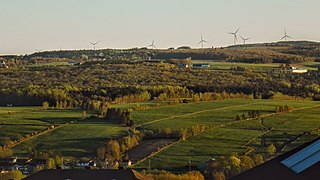Alma Bielenberg, Sidwell Friends School
Endless stretches of corn and grain illustrate the American farming ideal, but mass plantings of a single crop are not effective nor enduring compared to less mechanized methods. An ancient farming practice, agroforestry, provides an alternative.
As Earth’s human population grows, nourishing the world poses a new challenge. To make the most of the land around us for the longest possible time, nature’s resilience and adaptability could serve as a guide. Reintroducing trees into farming practices is one way to maximize efficiency and ensure sustainability to fulfill our need for food.
Agroforestry, a low-tech and traditional farming practice already used in one billion hectares of land worldwide, can be easily applied to our farmland for the benefits of increased productivity, carbon sequestration, and improved soil health. According to Mongabay, an environmental science publication, “agroforestry integrates trees, shrubs, and crops in a system that functions well together.” Agroforestry is predominant in the tropics, though it also exists in Europe, Australia, and the United States.
Alley cropping, an example of agroforestry, is what the United States Department of Agriculture (USDA) calls a “soil health management system” that incorporates rows or ‘alleys’ of trees between crop rows.
Silvopasture is another example of agroforestry. According to the USDA, “Silvopasture is the deliberate integration of trees and grazing livestock operations on the same land. These systems are intensively managed for both forest products and forage, providing both short- and long-term income sources.

Practices like alley cropping and the implementation of silvopasture systems can help to restore overworked and over-tilled soil, which is generally low in fertility. Because trees’ roots hold soil in place, these practices can reduce erosion, boosting soil health. According to Mongaby, a study conducted in 2014 found that planting trees like acacia on degraded land increased the plot’s productivity, more than tripling crop yields.
Roger Leakey, a crop physiologist and agroforestry expert, expanded, “By applying agroforestry we can rehabilitate the 35 percent of global agricultural land that is degraded, so that farmers would not have any need to deforest; this would also reduce pressures on natural forests and woodlands.”
Additionally, by implementing polycultures where different types of crops are grown on the same plot of land, agroforestry allows for the diversification of farmers’ incomes, making farms more economically resilient to the possibility of one crop dying out due to disease or a natural disaster.
“From a rural farmer’s perspective… the strength of agroforestry is that different plants supply different products at different times of the year, providing an extra source of income when the farmers’ expenses are high,” a Mongabay article points out.
United Nations Press Fellow Giovanni Ortolani argues, “Agroforestry is one of the agricultural systems we should invest in, as it is able to enhance natural resources while also increasing productivity.”
In addition to increasing farmland yields, agroforestry could also mitigate climate change’s impact on agriculture. With the increasingly unpredictable weather patterns caused by climate change, agroforestry creates “higher levels of organic matter [in soils], [increasing] resilience of soils that are being confronted with the more intense storms and dry periods,” according to Sustainable Agriculture Research and Education.
Additionally, by encouraging the planting of trees, agroforestry could store a significant amount of carbon. The Savanna Institute estimates, “With even a modest level of adoption, agroforestry could sequester 2.2 gigatons of carbon per year- more than any other agriculture land management approach out there.”
While some investment is necessary to apply agroforestry practices on farms, there are no strict requirements for integrating agroforestry, meaning that it can be modified to meet a farm’s budget, efficiency goals, geography, and demand.
Using the example of alley cropping, the USDA expands, writing, “Alley cropping can vary from simple systems such as an annual grain rotation between timber tree species to complex, multilayered systems that can produce a diverse range of agricultural products.”
The USDA also acknowledges that practices can and should vary by region, writing, “In North America, alley cropping most commonly includes high-value hardwood trees along with crops that create annual income while the trees are maturing. In tropical areas, alley cropping systems use trees to restore and protect soil fertility.”
The education of farmers and consumers on the benefits of agroforestry, as well as the certification of crops grown by agroforestry and the creation of government subsidies, can be used to popularize and justify investments in agroforestry practices.
Farmer’s education on sustainable agriculture would allow them to make the most informed and thoughtful decisions about how to use their land, giving them a science-based edge.
Investments by farmers become more productive when consumers reward sustainable or carbon-sequestering practices by purchasing the goods these practices produce. In order to make these choices, consumers need to be educated about where and how their food is made. Organizations certifying and recognizing higher standards, like the Non-GMO project, Fair Trade International, and Vegan Awareness, can aid consumers by giving them something to look for when food shopping.
Tax exemption could also encourage farmers to adopt sustainable practices. For example, a smaller tax could be payed on cropland implementing agroforestry than on cleared farmland.
Agroforestry is a low-tech strategy that can be used to improve soil health, crop yield, and increase resilience, while simultaneously sequestering carbon. As the agricultural industry is, by necessity, a part of our everyday lives, buying products that are farmed sustainably is a simple way to decrease one’s negative impact on the environment.
